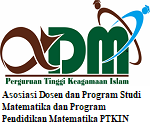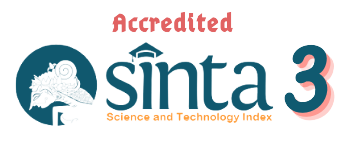Application of Machine Learning for Heart Disease Classification Using Naive Bayes
DOI:
https://doi.org/10.15642/mantik.2022.8.1.68-77Keywords:
Heart disease, Classification, Machine learning, Naive BayesAbstract
The Naive Bayes classifier uses an approximation of a Bayes theorem by combining previous knowledge with new ones. The purpose of this research is to develop machine learning using Naive Bayes classification techniques and as a decision system in producing fast and accurate classification accuracy in diagnosing cardiovascular diseases such as heart disease. Cardiovascular disease is the leading cause of death, 32% of all global deaths, of which 85% are caused by stroke and heart disease. Based on the results of the analysis, it was found that the accuracy of classification accuracy in the training data on patient data was classified as having and not having heart disease, respectively 83,21% and 83,1%. In data testing, the percentage of patient data classified as having and not having heart disease was 83,78% and 87,50%, respectively. Based on the AUC values in the training data and testing data, they are 83,15% and 85,24%, respectively. So, from these results, it can be concluded that the Naive Bayes method is good for classifying heart disease patient data.
Downloads
References
WHO, “Cardiovascular diseases (CVDs),” 2021. https://www.who.int/news-room/fact-sheets/detail/cardiovascular-diseases-(cvds) (accessed Jan. 21, 2022).
A. Maharani, Sujarwoto, D. Praveen, D. Oceandy, G. Tampubolon, and A. Patel, “Cardiovascular disease risk factor prevalence and estimated 10-year cardiovascular risk scores in Indonesia: The SMARThealth Extend study,” PLoS One, vol. 14, no. 4, pp. 1–13, 2019, DOI: 10.1371/journal.pone.0215219.
M. D. Ritchey, H. K. Wall, M. G. George, and J. S. Wright, “US trends in premature heart disease mortality over the past 50 years: Where do we go from here?” Trends Cardiovasc. Med., vol. 30, no. 6, pp. 364–374, 2020, DOI: 10.1016/j.tcm.2019.09.005.
M. A. Jabbar, B. L. Deekshatulu, and P. Chandra, “Classification of Heart Disease Using K- Nearest Neighbor and Genetic Algorithm,” Procedia Technol., vol. 10, pp. 85–94, 2013, DOI: 10.1016/j.protcy.2013.12.340.
F. Paquin, J. Rivnay, A. Salleo, N. Stingelin, and C. Silva, “Multi-phase semicrystalline microstructures drive exciton dissociation in neat plastic semiconductors,” J. Mater. Chem. C, vol. 3, pp. 10715–10722, 2015, DOI: 10.1039/b000000x.
C. Krittanawong et al., “Machine learning prediction in cardiovascular diseases: a meta-analysis,” Sci. Rep., vol. 10, no. 1, pp. 1–11, 2020, DOI: 10.1038/s41598-020-72685-1.
S. H. Hasanah, “CLASSIFICATION SUPPORT VECTOR MACHINE IN BREAST CANCER PATIENTS,” vol. 16, no. 1, pp. 129–136, 2022, [Online]. Available: https://doi.org/10.30598/barekengvol16iss1pp129-136.
S. H. Hasanah and E. Julianti, “Analysis of CART and Random Forest on Statistics Student Status at Universitas Terbuka,” INTENSIF J. Ilm. Penelit. dan Penerapan Teknol. Sist. Inf., vol. 6, no. 1, pp. 56–65, 2022, doi: 10.29407/intensif.v6i1.16156.
S. H. Hasanah and S. M. Permatasari, “Backpropagation Artificial Neural Network Classification Method in Statistics Students of Open University,” BAREKENG J. Ilmu Mat. dan Terap., vol. 14, no. 2, pp. 243–252, 2020.
S. Chen, G. I. Webb, L. Liu, and X. Ma, “A novel selective naïve Bayes algorithm,” Knowledge-Based Syst., vol. 192, no. xxxx, 2020, doi: 10.1016/j.knosys.2019.105361.
A. P. Wibawa et al., “Naïve Bayes Classifier for Journal Quartile Classification,” Int. J. Recent Contrib. from Eng. Sci. IT, vol. 7, no. 2, p. 91, 2019, doi: 10.3991/ijes.v7i2.10659.
H. Chen, S. Hu, R. Hua, and X. Zhao, “Improved naive Bayes classification algorithm for traffic risk management,” EURASIP J. Adv. Signal Process., vol. 2021, no. 1, 2021, DOI: 10.1186/s13634-021-00742-6.
A. W. Syaputri, E. Irwandi, and M. Mustakim, “Naïve Bayes Algorithm for Classification of Student Major’s Specialization,” J. Intell. Comput. Heal. Informatics, vol. 1, no. 1, p. 17, 2020, DOI: 10.26714/jichi.v1i1.5570.
A. Akbar Ritonga, Ibnu Rasyid Munthe, Masrizal, “Jurnal Mantik Jurnal Mantik,” Mobile-Based Natl. Univ. Online Libr. Appl. Des., vol. 3, no. 2, pp. 10–19, 2019, [Online]. Available: http://iocscience.org/ejournal/index.php/mantik/article/view/882/595.
A. Krichene, “Using a naive Bayesian classifier methodology for loan risk assessment: Evidence from a Tunisian commercial bank,” J. Econ. Financ. Adm. Sci., vol. 22, no. 42, pp. 3–24, 2017, doi: 10.1108/JEFAS-02-2017-0039.
R. Ardianto, T. Rivanie, Y. Alkhalifi, F. S. Nugraha, and W. Gata, “Sentiment Analysis on E-Sports for Education Curriculum Using Naive Bayes and Support Vector Machine,” (Journal Comput. Sci. Inf., vol. 13, no. 2, pp. 109–122, 2020, doi: http://dx:doi:org/10:21609/jiki:v13i2.885.
UCI Machine Learning, “Heart Disease Data Set.” archive.ics.uci.edu (accessed Sep. 08, 2021).
N. Boyko and I. Dosiak, “Analysis of machine learning algorithms for classification and prediction of heart disease,” CEUR Workshop Proc., vol. 3038, pp. 233–249, 2021.
M. Ismail, N. Hassan, and S. S. Bafjaish, “Comparative Analysis of Naive Bayesian Techniques in Health-Related for Classification Task,” J. Soft Comput. Data Min., vol. 1, no. 2, pp. 1–10, 2020, doi: 10.30880/jscdm.2020.01.02.001.
S. Hasanah and S. Permatasari, “Metode Klasifikasi Jaringan Syaraf Tiruan Backpropagation Pada Mahasiswa Statistika Universitas Terbuka,” BAREKENG J. Ilmu Mat. dan Terap., vol. 14, no. 2, pp. 243–252, 2020, doi: 10.30598/barekengvol14iss2pp249-258.
K. Hajian-Tilaki, “Receiver operating characteristic (ROC) curve analysis for medical diagnostic test evaluation,” Casp. J. Intern. Med., vol. 4, no. 2, pp. 627–635, 2013.
S. Yang and G. Berdine, “The receiver operating characteristic (ROC) curve,” Southwest Respir. Crit. Care Chronicles, vol. 5, no. 19, p. 34, 2017, doi: 10.12746/swrccc.v5i19.391.
F. Babic, J. Olejar, Z. Vantova, and J. Paralic, “Predictive and descriptive analysis for heart disease diagnosis,” Proc. 2017 Fed. Conf. Comput. Sci. Inf. Syst. FedCSIS 2017, no. October, pp. 155–163, 2017, doi: 10.15439/2017F219.
Downloads
Published
How to Cite
Issue
Section
License
Copyright (c) 2022 Hasanah Siti Hadijah

This work is licensed under a Creative Commons Attribution-NonCommercial-ShareAlike 4.0 International License.
- Authors retain copyright and grant the journal right of first publication with the work simultaneously licensed under a Creative Commons License that allows others to share the work with an acknowledgment of the work's authorship and initial publication in this journal.
- Authors are able to enter into separate, additional contractual arrangements for the non-exclusive distribution of the journal's published version of the work (e.g., post it to an institutional repository or publish it in a book), with an acknowledgment of its initial publication in this journal.
- Authors are permitted and encouraged to post their work online (e.g., in institutional repositories or on their website) prior to and during the submission process, as it can lead to productive exchanges, as well as earlier and greater citation of published work







.png)




